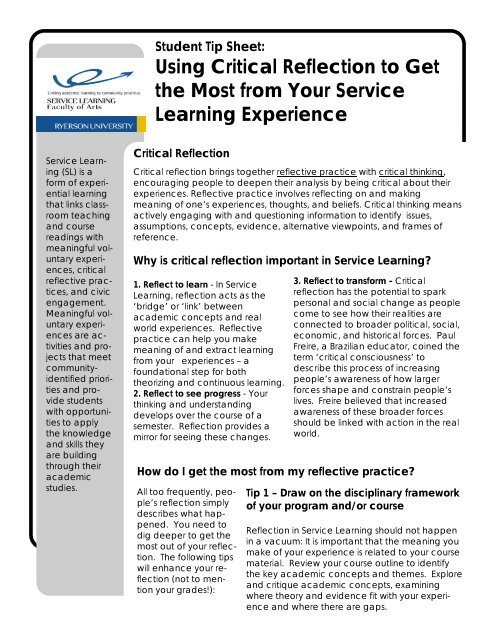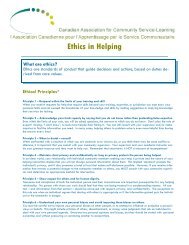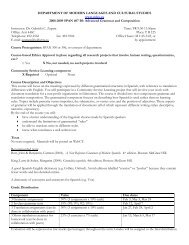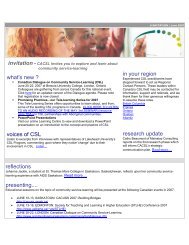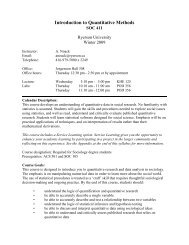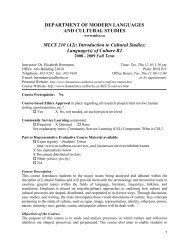Reflection - Canadian Association for Community Service Learning
Reflection - Canadian Association for Community Service Learning
Reflection - Canadian Association for Community Service Learning
Create successful ePaper yourself
Turn your PDF publications into a flip-book with our unique Google optimized e-Paper software.
Student Tip Sheet:Using Critical <strong>Reflection</strong> to Getthe Most from Your <strong>Service</strong><strong>Learning</strong> ExperienceV O L U M E 1 , I S S U E 1N E W S L E T T E R D A T E<strong>Service</strong> <strong>Learning</strong>(SL) is a<strong>for</strong>m of experientiallearningthat links classroomteachingand coursereadings withmeaningful voluntaryexperiences,criticalreflective practices,and civicengagement.Meaningful voluntaryexperiencesare activitiesand projectsthat meetcommunityidentifiedprioritiesand providestudentswith opportunitiesto applythe knowledgeand skills theyare buildingthrough theiracademicstudies.Critical <strong>Reflection</strong>Critical reflection brings together reflective practice with critical thinking,encouraging people to deepen their analysis by being critical about theirexperiences. Reflective practice involves reflecting on and makingmeaning of one’s experiences, thoughts, and beliefs. Critical thinking meansactively engaging with and questioning in<strong>for</strong>mation to identify issues,assumptions, concepts, evidence, alternative viewpoints, and frames ofreference.Why is critical reflection important in <strong>Service</strong> <strong>Learning</strong>?1. Reflect to learn - In <strong>Service</strong><strong>Learning</strong>, reflection acts as the‘bridge’ or ‘link’ betweenacademic concepts and realworld experiences. Reflectivepractice can help you makemeaning of and extract learningfrom your experiences – afoundational step <strong>for</strong> boththeorizing and continuous learning.2. Reflect to see progress - Yourthinking and understandingdevelops over the course of asemester. <strong>Reflection</strong> provides amirror <strong>for</strong> seeing these changes.3. Reflect to trans<strong>for</strong>m - Criticalreflection has the potential to sparkpersonal and social change as peoplecome to see how their realities areconnected to broader political, social,economic, and historical <strong>for</strong>ces. PaulFreire, a Brazilian educator, coined theterm ‘critical consciousness’ todescribe this process of increasingpeople’s awareness of how larger<strong>for</strong>ces shape and constrain people’slives. Freire believed that increasedawareness of these broader <strong>for</strong>cesshould be linked with action in the realworld.How do I get the most from my reflective practice?All too frequently, people’sreflection simplydescribes what happened.You need todig deeper to get themost out of your reflection.The following tipswill enhance your reflection(not to mentionyour grades!):Tip 1 – Draw on the disciplinary frameworkof your program and/or course<strong>Reflection</strong> in <strong>Service</strong> <strong>Learning</strong> should not happenin a vacuum: It is important that the meaning youmake of your experience is related to your coursematerial. Review your course outline to identifythe key academic concepts and themes. Exploreand critique academic concepts, examiningwhere theory and evidence fit with your experienceand where there are gaps.
Tip 2 - Three key questions to take you beyonddescription: What? So what? Now what?What?: Start by describing and examining what happened duringyour voluntary experience. This includes observations about your ownand other people’s thoughts, feelings, and behaviours.So what?: Make meaning of ‘what’ happened. Move the solutionsthat are found. Explore how theory can be used to improve practice.Explore how practice can be used to improve theory. your thinkingfrom description to analysis and interpretation. Explore how theacademic concepts you are learning in your lectures and readings relateto your experiences.Now what?: Identify how what you have learned can be used in thereal world. Explore how one’s understanding of a social issue affectsthe solutions that are found. Explore how theory can be used to improvepractice. Explore how practice can be used to improve theory.Tip 3: Broaden your view by moving from Portrait to Landscape ThinkingSimilar to photography, how you frame an issue affects what you see and the solutions youseek. Portrait frames explore issues by focusing primarily on people or events in a particularmoment in time, while ignoring contextual in<strong>for</strong>mation. Portrait frames lead people tofocus on personal responsibility <strong>for</strong> social issues. Landscape frames, on the other hand,take a broader view to examining an issue: people’s lives and events are examined in relationto the policies, institutions, and larger social, political, economic, and historical<strong>for</strong>ces that surround them. Landscape frames lead to an understanding of the shared responsibilityof individuals and society <strong>for</strong> social issues.Tip 4: Dig deeper by asking ‘why?’ atleast three times!A simple strategy <strong>for</strong> deepening your analysis is toquestion your answers by asking “why?” at leastthree times. This encourages you to look beyondwhat is immediately evident and get closer to rootissues.Tip 5: Know yourselfYou will be more effective in yourwork if you are both self‐ aware (i.e.,knowing who you are, what youbring to the project, and how youwant to grow) and socially aware(i.e., understanding complex socialissues).References:Bringle, R.G. and Hatcher, J.A (2003). <strong>Reflection</strong> in service learning: Making meaning of experience.In Campus Compact (2005). Introduction to service-learning toolkit: Readings and resources<strong>for</strong> faculty, second edition. Providence, RI: Campus Compact.Dorfman, L., Wallack, L., and Woodruff, K. (2005). More than a message: Framing public healthadvocacy to change corporate practices. Health education and Behavior, 32(3), 320-336.Ginwright, S. and Cammarota, J. (2002). New terrain in youth development: The promise of asocial justice approach. Social Justice, 29(4), 82 – 95.Scriven, M. and Paul, R. (n.d). Defining critical thinking. Retrieved January 4, 2008 from http://www.criticalthinking.org/aboutCT/define_critical_thinking.cfm


